The state of email marketing and SMS for fashion ecommerce: benchmarks, examples, and trends
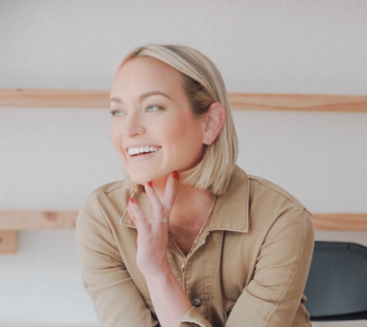
For fashion brands, pandemic headwinds have yet to ease up.
In the BoF-McKinsey State of Fashion 2022 survey, the top 3 words fashion executives chose to describe their business and industry were “recovery” (59%), “challenging” (50%), and “changing” (42%).
While some fashion brands prospered in 2020-2021, especially those focused on consumer trends of comfort and new work-from-home styles, the majority of fashion brands had to quickly pivot to stay afloat, with consolidation and bankruptcy as their next best bet.
In 2022, McKinsey predicts that global fashion sales will reach 103-108% of 2019 levels. As a result, many fashion executives are looking for growth this year after 18-24 months of riding out the highs and lows of the global pandemic storm.
But growth won’t come easy. Many pandemic-related issues persist in 2022—specifically, supply chain woes including logistical bottlenecks, manufacturing delays, high shipping costs, and materials shortages. Fashion brands must increase prices in response, while squeezing their margins and supply on hand.
And those rising prices are hitting particularly price-conscious consumers. Inflation is growing in the US and globally, causing bear markets and concerns about a long-term recession. Consumers, as a result, are holding their wallets tighter: 8 in 10 plan to change their shopping behavior due to inflation.
As a result, discount fashion brands and luxury fashion brands are likely to see the most stabilization in this market. It’s mid-market brands that will be squeezed as consumers shift their buying habits and brand preferences based on macroeconomic forces.
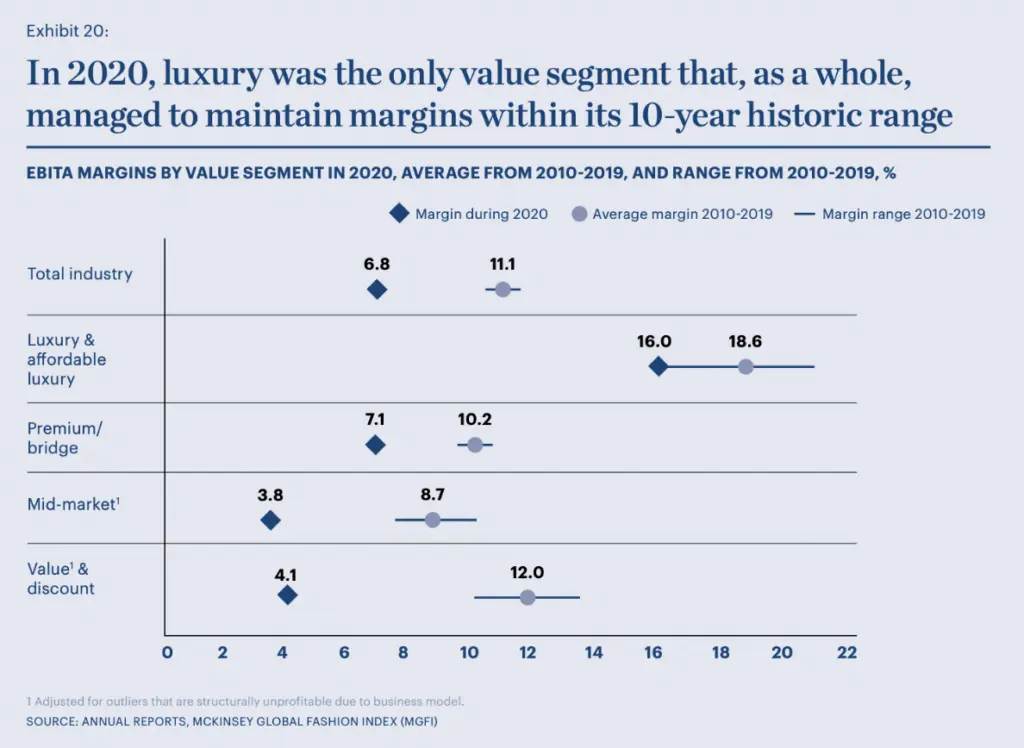
How can today’s fashion brands market their way to success in this environment?
The short answer is to nurture customer relationships and develop omnichannel experiences.
The long answer is much more nuanced than that.
To help you navigate this new fashion ecommerce landscape, we’ve gathered the top trends, benchmarks, examples, and more so your team can build a crisis-proof strategy that builds a stronger brand along the way.
The state of fashion: DTC-only is no more
The pandemic only accelerated already-growing trends within the fashion industry. Chains targeting the middle class, for instance, like Macy’s, JCPenney, and Bon-Ton, never fully recovered from the Great Recession. There are many reasons for this:
- Amazon’s boom during the Great Recession and beyond
- Heavy investment by of those chains into larger physical footprints instead of into digital storefronts
- Shrinking incomes for “the middle 40%” of the country, according to a 2018 study from the consulting firm Deloitte—making discount fashion brands like Marshalls and TJMaxx more attractive to the middle-class shopper
Meanwhile, up-start fashion brands using site-builders like Shopify, BigCommerce, WooCommerce, and Wix quickly grew their online presence utilizing Facebook’s new advertising platform, which offered unprecedented targeting capabilities—and at very low costs in the early 2010s.
But rising ad costs on Facebook due to increased competition made the platform less sustainable overtime, and Apple’s iOS updates during the pandemic caused widespread fashion marketing reinvestment into different acquisition channels outside of Facebook.
Many of those reinvestments went to wholesale partnerships with chains like Target, where consumers were already shopping for essentials and brands could get extra eyes on their products.
While these direct-to-consumer fashion brands were expanding into more traditional wholesale relationships, more established fashion brands shifted their investment toward digital marketing efforts, launching online stores and using modern marketing tactics like influencer marketing and partner marketing to drive high amounts of traffic and sales.
Today, brands that have surpassed $5M in annual revenue are rarely DTC–only. All growing fashion brands have moved to the omnichannel model, in which digital, physical, and wholesale each play a crucial role.
The future of fashion ecommerce and marketing
By necessity, fashion brands of all sizes are becoming more similar in their omnichannel approach to marketing. But that doesn’t mean how they execute those marketing strategies is similar at all.
Personalization underpins many of the major fashion ecommerce trends, as brands work to bring unparalleled and unique experiences to their customers in the hopes that those experiences convert and build long-term loyalty.
This drive toward experiences and personalization at scale, as well as a desire to speed up marketing execution and reduce tech team overhead, is moving many teams back to SaaS tools and technologies, rather than building in-house.
As a result, here are the 5 main fashion marketing trends happening in the market today:
Investments in technology
Most fashion brands, including legacy brands that said they’d never have an online store, now have online stores that run very similarly to how DTC stores have run for over a decade now.
The main differences between legacy fashion brands and DTC fashion brands revolve around their tech stack. But even that’s beginning to converge.
With supply chain issues and inflation causing inventory shortages and less consumer spending, fashion brands are leaning into technology to address some of the biggest pain points, such as supply chain issues, the need for more sustainable solutions, the death of third-party cookies, and customer retention:
- Enterprise resource planning tool (ERP): to understand where your goods are and manage the supply chain, including what’s in the warehouse, what’s with third-party logistic providers, what’s in wholesale stores like Target, etc.
- Order management system (OMS): to see and manage all your orders across all channels in a single place
- Customer data platform (CDP): to understand how customers are interacting with the brand, and build single customer profiles that can be easily segmented (the foundation of personalization)
- Customer relationship management tool or email service provider (ecommerce CRM or ESP): to communicate with customers via email and SMS
- Ecommerce platform: to drive traffic, grow brand awareness, and capture ecommerce sales on your owned website
A COVID-fueled ecommerce surge highlighted the pivotal role technology plays in the fashion industry. McKinsey predicts that now, fashion companies will ramp up their technology investments from between 1.6-1.8% of sales in 2021 to between 3-3.5% by 2030.
Creating exceptional customer experience and engagement is imperative for fashion businesses, and now is the time to get your tech stack in order so you can deliver omnichannel customer experiences at scale.
Klaviyo integrates seamlessly with Shopify, BigCommerce, Magento, WooCommerce, Salesforce Commerce Cloud, Prestashop, Wix, and more through one-click integrations. Custom-built ecommerce solutions can also integrate with Klavyo via our APIs.
Omnichannel engagement
Looking at some of the most successful fashion brands’ playbooks, one thing is certain: omnichannel is the key to success.
Customers don’t look through the lens of separate shopping channels. They expect a seamless shopping journey from beginning to end—no matter the channel.

Plus, customers have high expectations of brands when it comes to how they advertise, how they communicate, and more. Brands have responded by trying to implement more personalized ecommerce experiences across email marketing and SMS marketing—to varying levels of success.
One big reason brands struggle to deliver omnichannel, personalized experiences is that they lack a central data repository that marketers can easily access and use to create segmented campaigns.
This is what an ecommerce CDP is built for—and why many brands are moving from single-point CDP, email, and SMS solutions to tech tools that can do it all.
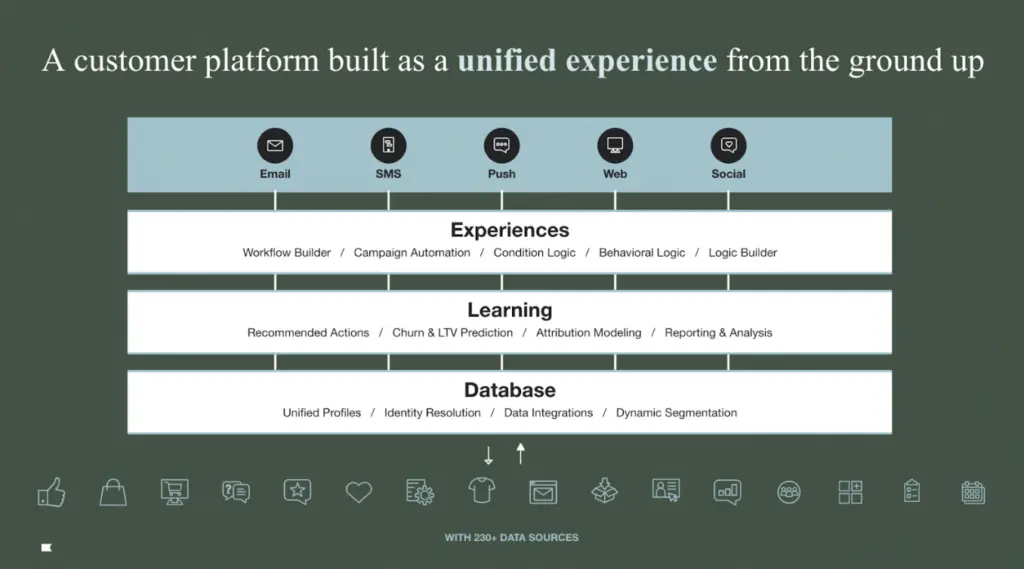
These tools allow fashion ecommerce marketers to segment quickly and easily, then use dynamic blocks to turn 1:many personalization into what looks like 1:1 personalization to the customer.
This is how fashion ecommerce brands are scaling personalization in an omnichannel environment.
Social commerce
Integrating social experiences and ecommerce transactions simplifies the path to purchase, helping customers discover the products they want while scrolling through their social media accounts.
Social commerce is also part of the omnichannel landscape, in which consumers want to interact with and purchase from brands regardless of the channel they’re in.
This is especially true of fashion brands: 70% of consumers buy clothing on social media apps, according to Bazaarvoice. Aware of this behavioral shift, 37% of fashion executives cited social commerce as one of the top 3 themes that will impact their business in 2022, McKinsey reports.
This means that fashion brands need to leverage purchase button tools on social media as quickly as they can, instead of forcing users back to their website to buy. Social commerce has matured, and even tools like Shopify offer integration with Facebook and others to facilitate immediate on-platform purchasing.
It isn’t 100% seamless yet, though, and that’s not on fashion brands. Building that technology rests on the shoulders of the social media brand.
In the meantime, many fashion brands are building out engaging content on social platforms to push users back to dedicated shopping landing pages, in the same way B2B brands have long used dedicated paid landing pages to convert leads.
Online quizzes have also become popular for fashion marketing, where brands push engaged social media users to their quiz to collect zero-party data, personalize their experience with the brand, and offer product recommendations after an email capture.
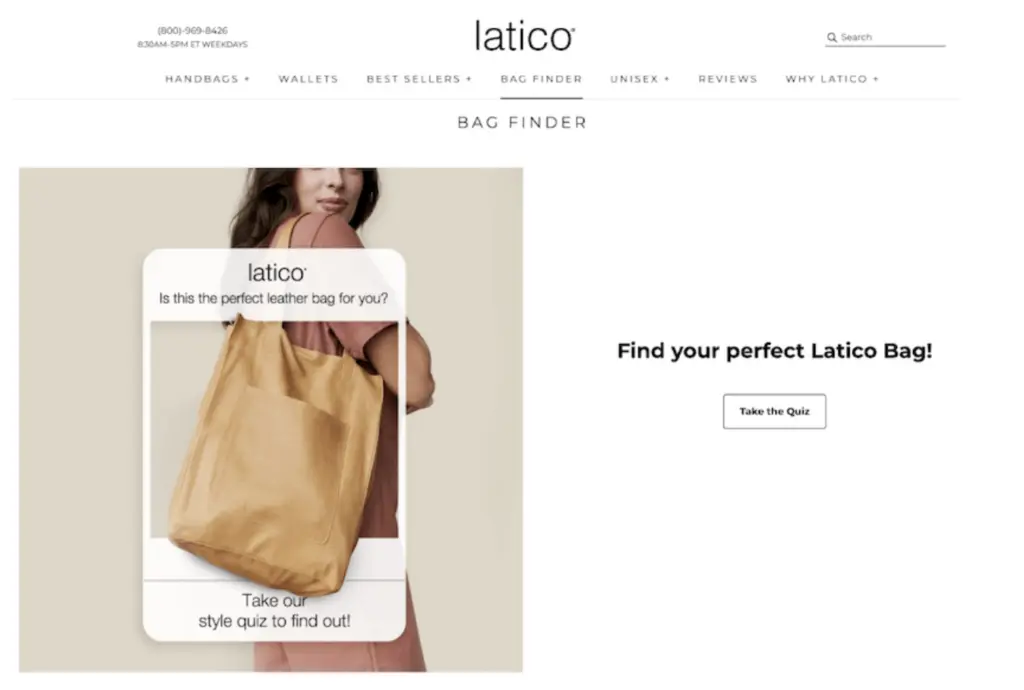
Sustainability
The fashion industry in the midst of an environmental reckoning. Consumers are getting more informed about fashion’s environmental and social impact, which forces companies to prioritize sustainability objectives.
Statista’s research shows that 42% of global customers purchase eco-friendly and sustainable products. And according to another research from Accenture, 52% of shoppers are more likely to purchase from a company that shares their values.
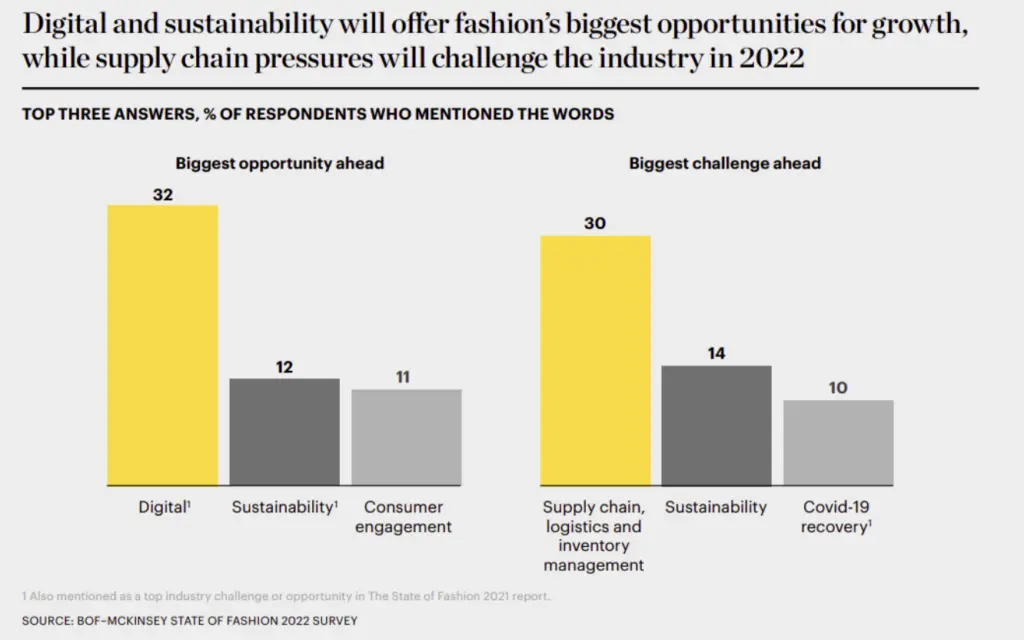
Overproduction, materials sourcing, carbon footprint, and regulatory compliance are just some of the pain points fashion brands need to address moving forward.
And things are finally starting to happen: for example, approximately 2 out of 5 fashion executives plan to adopt product passports in 2022 or have already done so, according to McKinsey. Product passports gather and share data on a product and its supply chain in order to give consumers a better understanding of the product’s environmental impact.
These types of initiatives boost authenticity, transparency, and sustainability—all of which are essential for a meaningful impact and mindset change.
Preparation for the metaverse
Fashion businesses are amped about the metaverse, an integrated network of 3D virtual worlds, and the potential it holds for future growth. By 2026, a quarter of people will spend at least 1 hour a day in the metaverse for work, shopping, education, social interactions, and entertainment, according to Gartner.
And while there’s still a long way to go before we reach the true realization of the metaverse, fashion businesses are already seeing some tangible benefits of the virtual ecosystem.
A recent report from McKinsey states that global spending on virtual goods reached an estimated $110B in 2021—more than double the total in 2015, with around 30% attributed to virtual fashion.
Much of this growth in virtual goods purchasing is directly related to growth in gaming platforms and adoption, where consumers are buying goods for their virtual characters. Brands like Nike, Adidas, and Vans World have already started selling goods for this specific purpose.
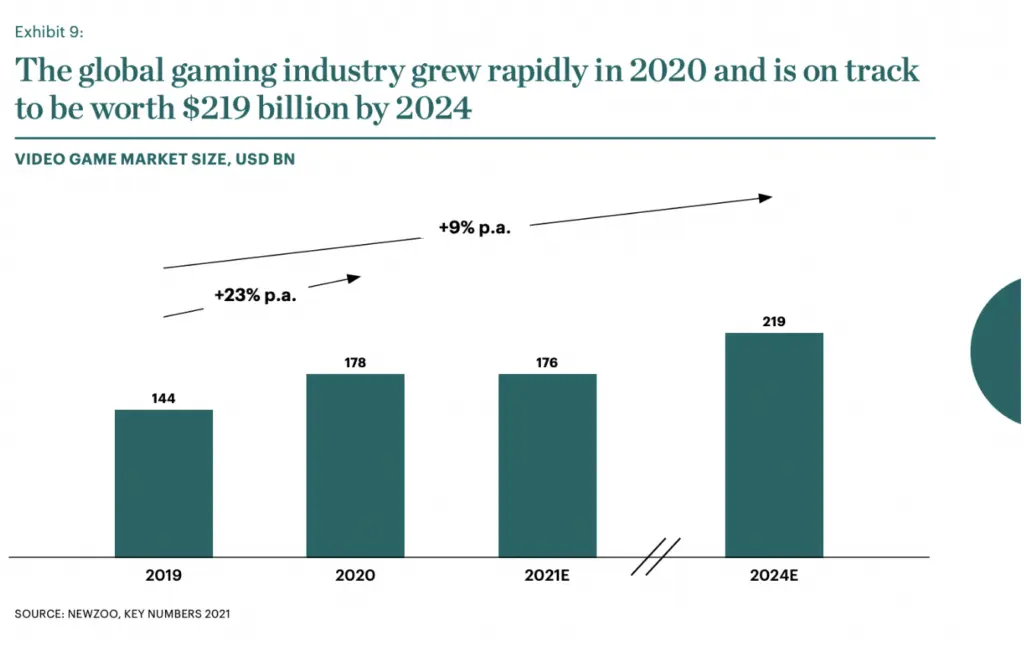
According to the same report, fashion companies focused on metaverse innovation and commercialization could generate more than 5% of revenue from virtual activities over the next 2-5 years.
Top 5 fashion ecommerce email and SMS marketing trends
While there are many uncertainties regarding the future of fashion, one thing is for sure: fashion brands must focus on growing their relationships with customers and personalizing the customer experience through targeted communication that resonates.
To achieve this, brands need a laser focus on email and SMS marketing—the main channels of customer communication—and a solid understanding of how to use these tools to drive more revenue.
Here are the latest email marketing and SMS trends fashion brands are using to grow revenue, grow loyalty, and offset many of the macroeconomic challenges the industry is facing.
1) Hyper-personalization of experiences
Keeping up with customer demands is harder than ever. Today’s consumers are comparing your brand to the best digital experience they’ve ever had—not just in your industry, but across the board. To stay competitive, you need to offer a personalized experience and meet customers’ ever-growing expectations.
Data from McKinsey shows that 71% of global consumers want companies to deliver personalized communications and products, and 76% are unhappy when they don’t get it.
No surprise, then, that growth-focused fashion brands are already nailing the personalization game through targeted email marketing and SMS messaging.
“Personalizing your marketing strategy to meet the needs of your customer segments will help ecommerce apparel and accessories brands stand out in 2022,” says Spencer Flaherty, internal marketing manager, Groove Commerce. “Utilizing customer demographics and shopping behavior helps merchants cater their email and SMS messages to meet users at every stage of the customer lifecycle. Presenting on-page product recommendations and cart abandonment reminders, and promoting new products to those who have expressed interest in similar items, are guaranteed ways to drive conversions.”
Consider specialty skate shop, sneaker, and clothing brand Premier, which focuses on tailoring a unique online shopping experience for customers. To achieve that goal, Premier sends customers personalized messages based on their interests.
One of the ways Premier creates a memorable customer experience is by setting a price drop trigger, notifying customers when a product they were interested in is on sale.
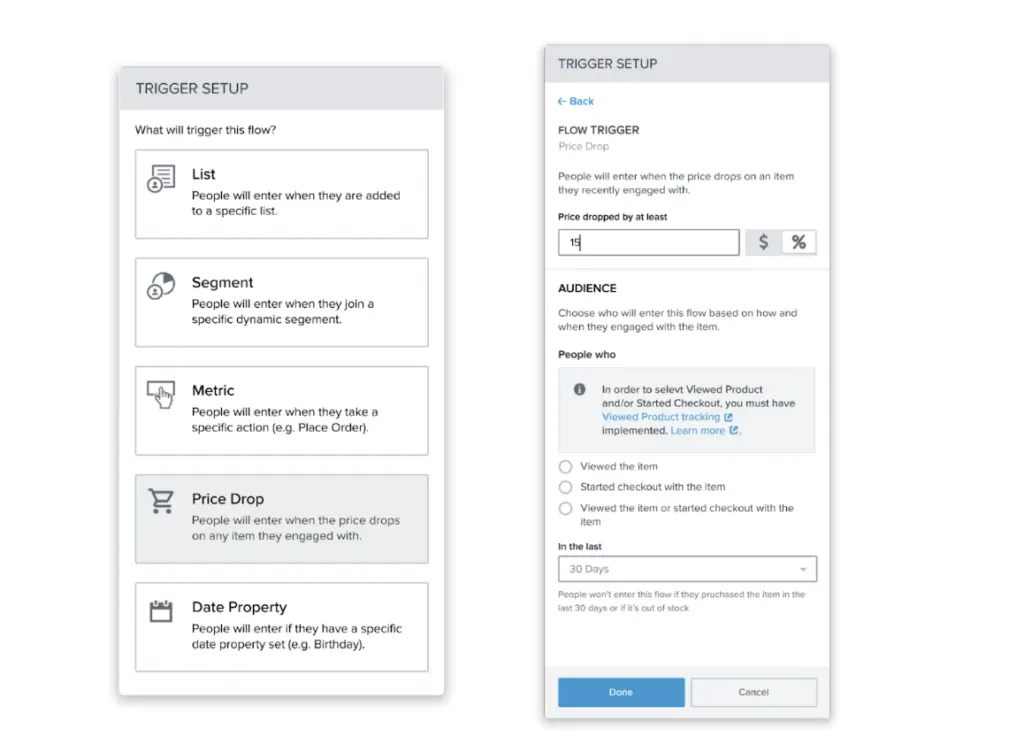
With this simple trigger set-up, Premier reported a 73% email open rate, 12% email click rate, and $4K+ in revenue in less than a month.
With this simple trigger set-up, Premier reported a 73% email open rate, 12% email click rate, and $4K+ in revenue.
Personalization like this fuels positive and memorable customer experiences, and it’s up to fashion brands to use it as a powerful tool to stand out in a crowded inbox.
Many fashion brands stop short of 1:1 personalization like this, thinking that it’s too hard to implement.
That may be true on some tools, but with a customer platform like Klaviyo, it’s as simple as creating segments of your audience based on the zero- and first-party data you collect, then using dynamic content blocks to create a personalized email or SMS experience.
You can even build dynamic content blocks into your SMS and email automations, so that your personalized flows continue without having to manually launch them.
2) Automation
Setting up all of your email and SMS flows manually is like building a house of cards. One wrong move, and everything can fall apart. The good news is SMS and email automation can help you overcome this hurdle.
From welcome series, browse abandonment, cart abandonment, and educational emails to product review, cross-sell, up-sell, and replenishment flows, automation helps fashion brands engage customers and increase their bottom line.
Setting up email and SMS marketing automation for ecommerce is like creating your own perpetuum mobile that does all the heavy lifting, leaving you time to focus on the things that really move the needle for your business.
Sustainable apparel brand Brava Fabrics relies heavily on email marketing, and for good reason: the brand automates the entire customer journey with triggers based on customer behavior. As a result, 60% of Brava Fabrics’ email revenue comes from automated emails.
One of the many automated email series Brava Fabrics has implemented is the review follow-up email. The brand uses Typeform to collect customer product reviews. Then, thanks to Klaviyo’s integration with Typeform, they create personalized flows based on what kind of reviews customers give.
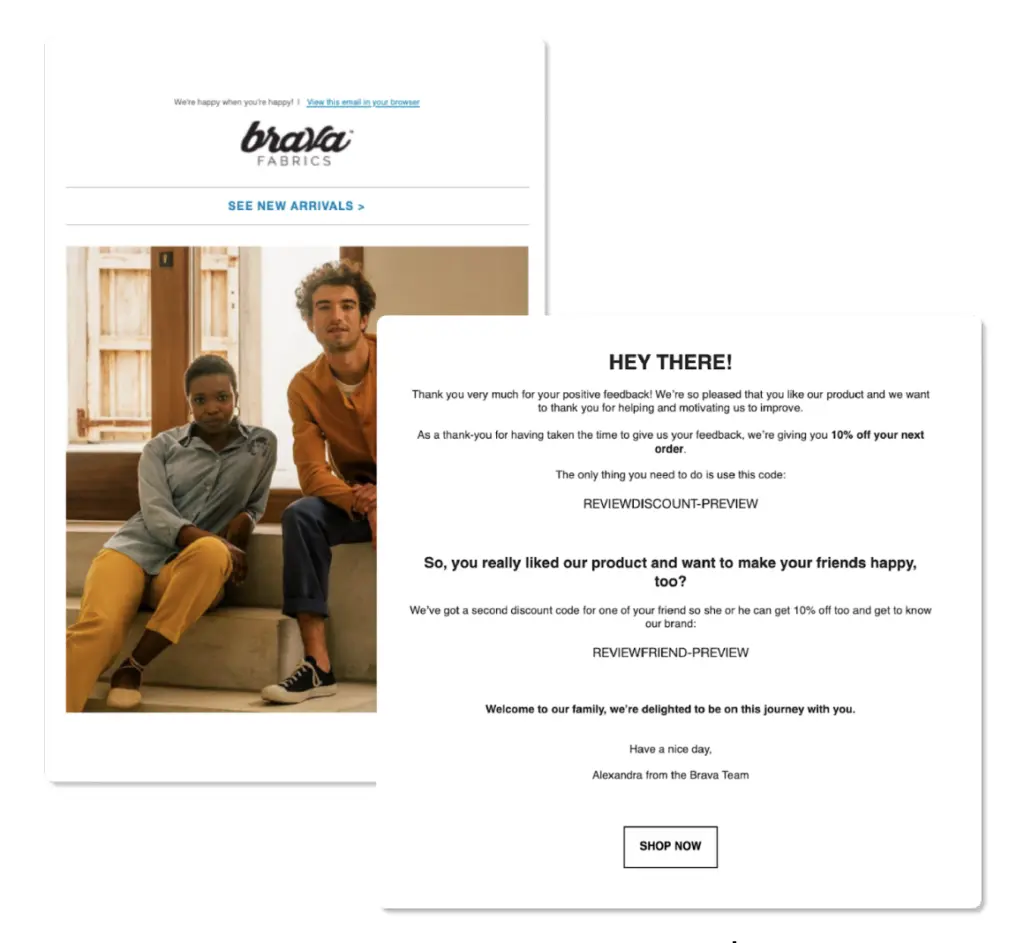
For example, Brava Fabrics uses this email to give happy customers a discount—and encourages them to become brand advocates by offering a discount code they can share with friends.
Fashion brands rely on automation for SMS marketing as well. Proozy is known for discount and clearance apparel, footwear, and gear from leading retail brands. The brand has an SMS-specific welcome series to encourage a customer’s first order.

Proozy reports an average order value of $74 from new subscribers who convert.
Proozy also combines email and SMS to maximize its efforts. The brand added SMS branches to its existing browse abandonment and cart abandonment series. That way, if the first message doesn’t lead to a purchase, Proozy can reach out to customers on a different channel.
3) Customer-First Data™
The cookie apocalypse started when big tech organizations like Apple and Google announced data privacy changes to protect users. This removed a lot of third-party data from the picture and forced brands to think about ways to gather Customer-First Data—the combination of first- and zero-party data.
In response, fashion brands have started experimenting with sign-up forms, quizzes, surveys, and post-purchase automations to collect data with the knowledge, permission, and explicit consent of prospects and customers.
Baby boutique Caden Lane uses a sign-up form to collect emails, but also segments subscribers based on the age of the child they are shopping for. This helps them collect additional zero-party data, as well as segment and personalize each customer’s experience.
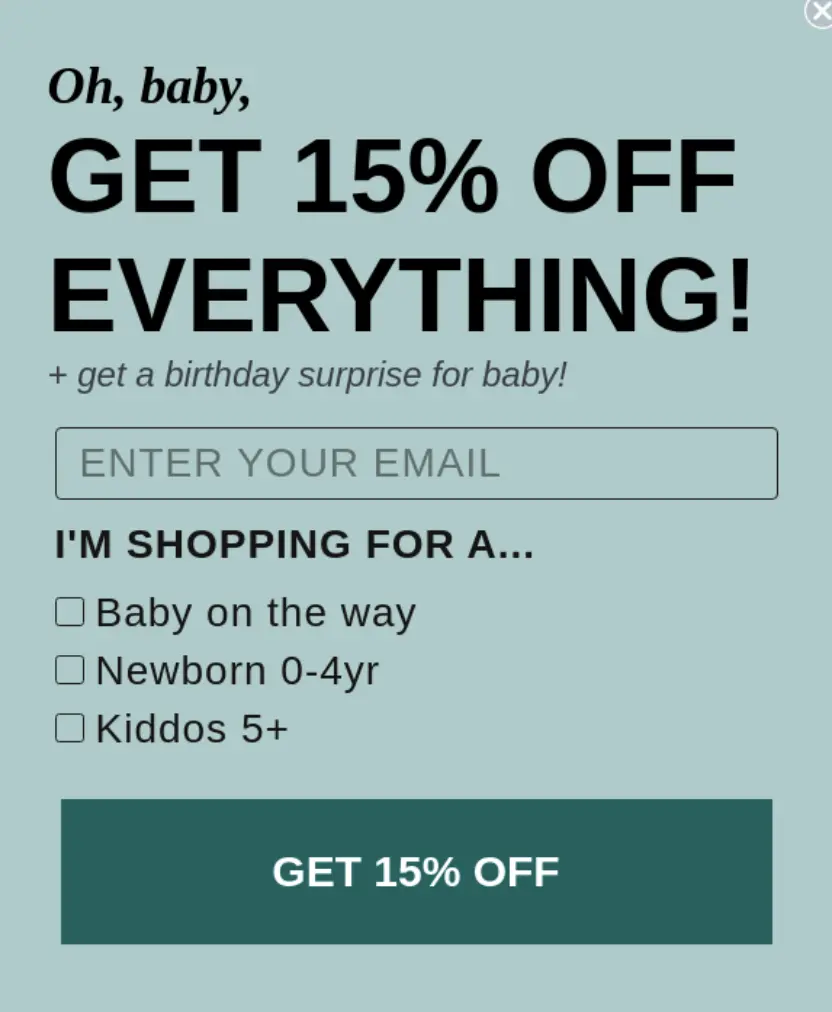
Adding a simple question to your sign-up form can help you segment subscribers and send them targeted messages, ultimately boosting sales.
Another way to collect Customer-First Data is to use quizzes to give your website visitors personalized product recommendations. Shapewear brand CYSM, for example, offers product quizzes to help customers find what they need.
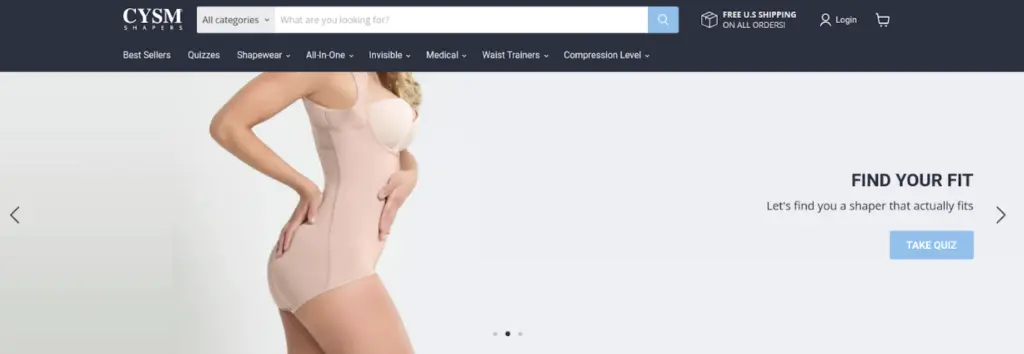
CYSM promotes the quizzes on their homepage and also has a dedicated webpage where visitors can explore different quizzes. Based on the data CYSM gathers, the brand can later personalize email marketing efforts to make more sales. For example, if the visitor selects shapewear for medical purposes, CYSM sends an email with tips for better posture:

Focusing on Customer-First Data helps fashion brands deliver messages that resonate with customers and create a delightful customer experience—all while growing their owned data warehouses.
4) Customer relationship marketing to boost retention
Acquiring new customers is more difficult than ever as competition grows and the old DTC and ecommerce playbook of advertising on Facebook becomes less and less sustainable.
As a result, fashion brands have shifted strategies toward customer retention. Nurturing a healthy relationship with your customers is your best bet for increasing customer lifetime value.
Using customer lifetime value data within Klaviyo: If you’re looking to level up with Klaviyo by using customer lifetime value to better target your customers, this free course will walk you through exactly how to do it.
And, since communication is the foundation of a healthy relationship, email and SMS marketing can help you engage and retain customers.
Swimwear and apparel brand Summersalt uses post-purchase emails like this one to thank customers and offer them a coupon code for a complimentary product:

Tools like Klaviyo offer SMS and email automations for thank-you flows like this, as well as:
- Happy birthday flows
- Countdown to birthday series
- Welcome series
- First-purchase anniversary flows
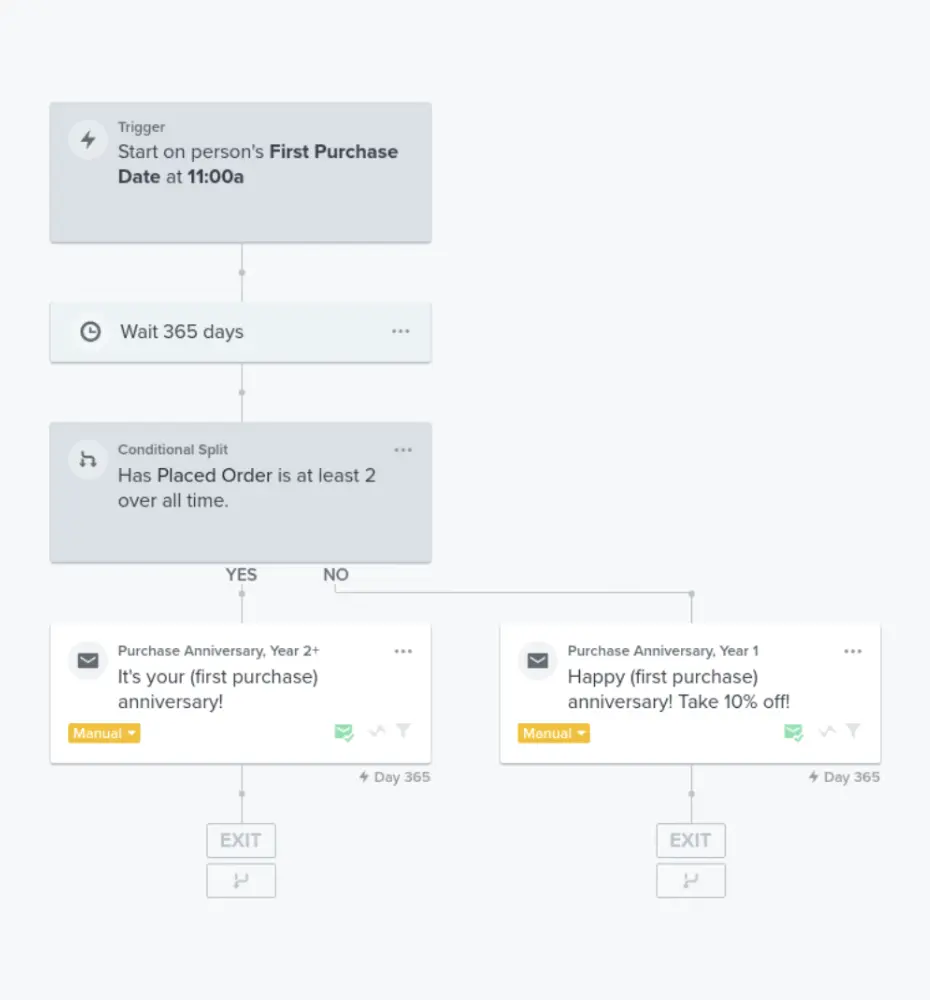
Building customer relationships takes time and dedication, and doubling down on email and SMS is key to keeping customers engaged and happy. But it’s not just about what you send. It’s also about when you send.
Be sure to use tools that don’t let you send SMS messages during legal quiet hours, and look for tools that offer AI and machine learning recommendations on which times and days are best to send to your audience long-term.
5) Customer education at the forefront
One thing successful fashion brands have in common is their dedication to delivering a stellar online experience. A big part of that is customer education.
Modern fashion brands provide customers with the resources they need to make informed purchase decisions. London-based lingerie brand Heist Studios, for instance, uses both product and content marketing to decommoditize its product. Customers are guided on an educational journey about product innovations and why they matter.
“To continue to grow efficiently, you need distinctive communications your customer can relate to. Content is essential, and we use it to engage customers in conversation at every touchpoint in their lifecycle,” says Hannah Craik, chief marketing officer, Heist Studios.
Heist gets into the nuts and bolts of what makes their shapewear revolutionary, giving consumers all the information they need before purchasing.

Leading brands know that customer education is a never-ending process. The misconception that a brand’s job is over the moment a customer makes a purchase is finally fading away. Staying top of mind is critical to encouraging the customer to make another purchase.
Email marketing benchmarks for fashion
What are the most important email metrics? What is a good open rate? And how are other fashion brands performing?
These are just some of the questions that are top of mind for fashion businesses.
To answer your questions and help you understand how you stack up against other brands in the fashion industry, we’ve compiled ecommerce email benchmarks for fashion ecommerce brands.
The average email open rate for apparel and accessories is 31.82%, with a 1.64% click rate and 0.08% conversion rate. Automated email flows perform well, with 50%+ open rates across the board. Post-purchase email flows have the highest average open rate at 60%.
Welcome email flows have an average click rate of 6.25%, with a 2.12% conversion rate and $2.35 revenue per recipient.
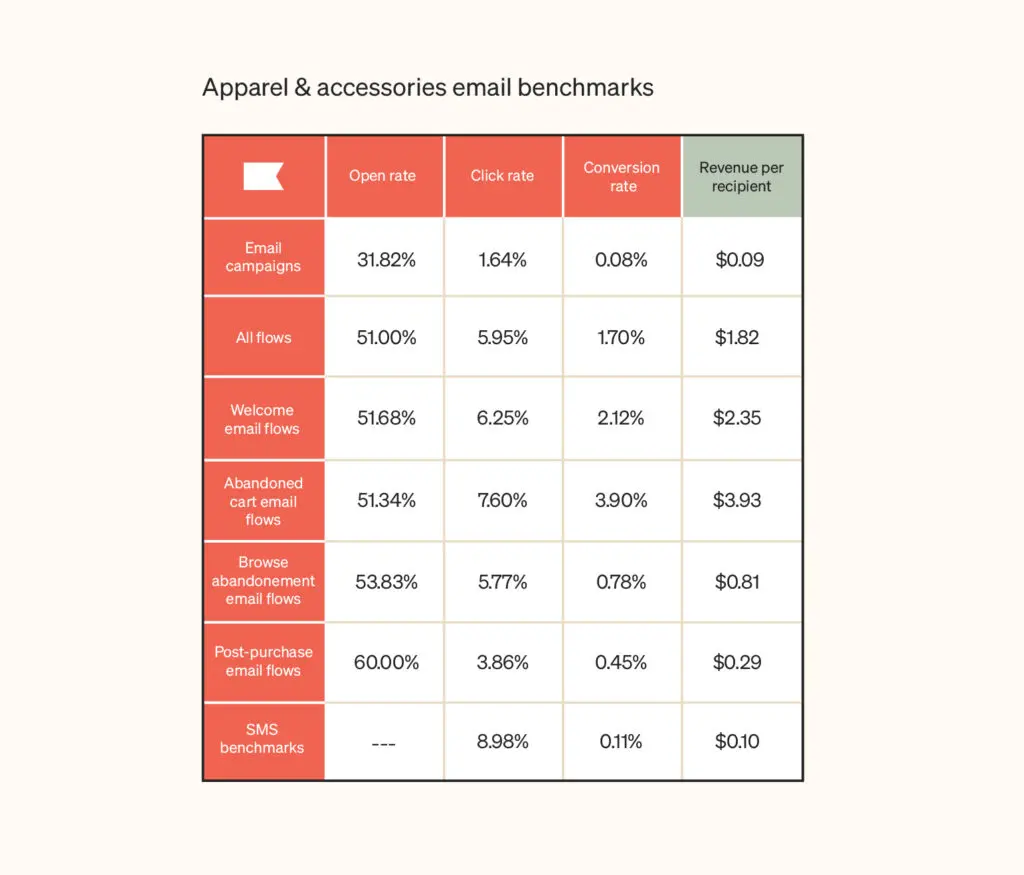
Abandoned cart email flows have the highest click rate at 7.6%, as well as a high conversion rate at 3.9% and $3.93 revenue per recipient.
For jewelry email benchmarks, the average email campaign open rate is 30.81%, with a 1.46% click rate, 0.05% conversion rate, and $0.06 revenue per recipient.
It’s interesting to note that jewelry brands have a slightly lower email open rate compared to apparel and accessories brands but a higher click rate for every email flow. The conversion rate and revenue per recipient, meanwhile, are insignificantly lower compared to apparel and accessories brands.
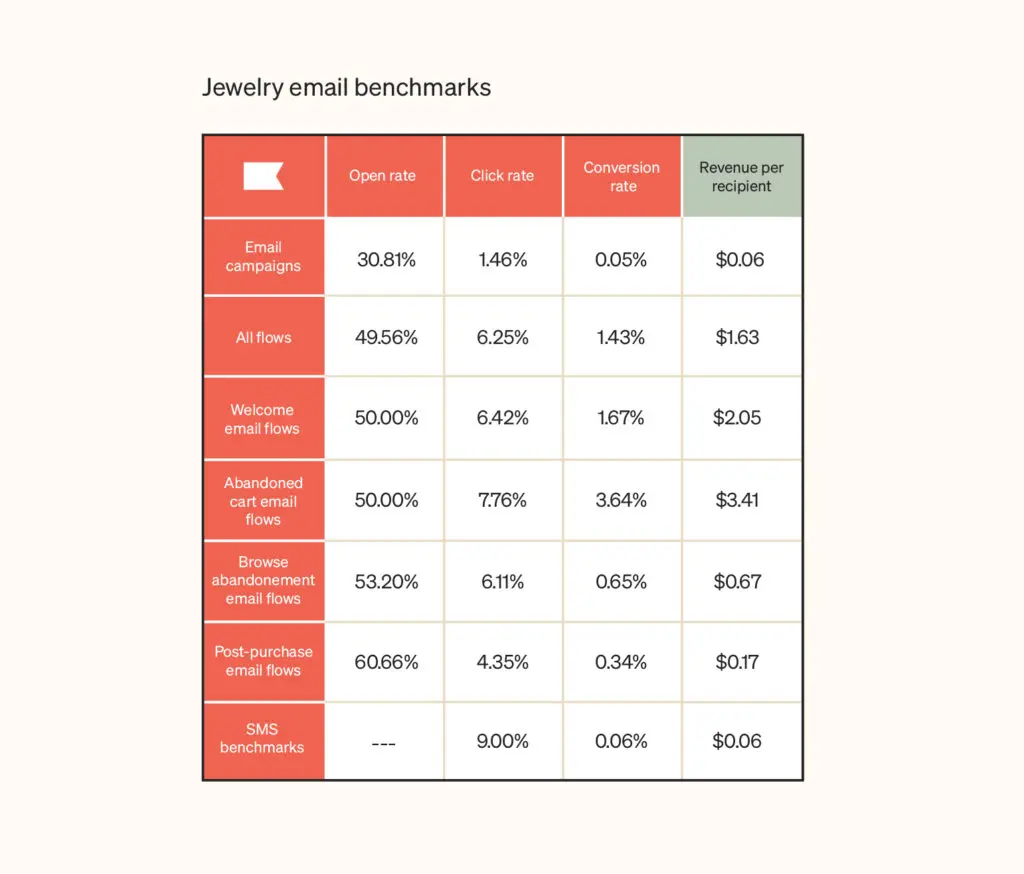
The top-performing example of email automation for jewelry brands is the abandoned cart email, which has a 7.76% click rate, 3.64% conversion rate, and $3.41 revenue per recipient.
SMS marketing benchmarks for fashion
There are more than 6B smartphone users in the world, according to BankMyCell. That’s more than 80% of the world’s population.
To make the most out of this opportunity, marketers have started to ramp up their texting efforts. Data from Statista shows that 75% more consumers used SMS to contact businesses in 2020 than in 2019.
If SMS is one of the key channels for your fashion businesses, here are the most important ecommerce SMS benchmarks for fashion brands.
The average form conversion rate in the apparel and accessories category sits at 2.17%. Average click rate is 8.98%, and average conversion rate is 0.11%. Open rate is a vanity metric for SMS, as customers have to open the message to get rid of the notification. Revenue per recipient in the apparel and accessories industry averages $0.10.
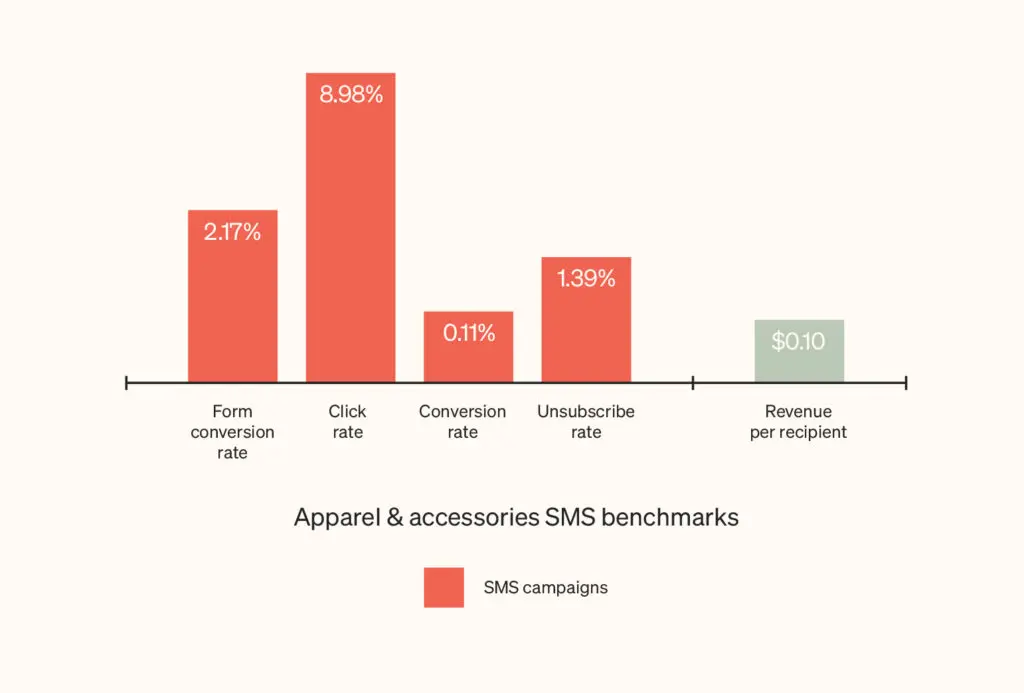
If we compare jewelry SMS benchmarks with apparel and accessory benchmarks, we can spot very slight differences. The form conversion rate for jewelry SMS is 2.16%, and it’s almost identical to the one for apparel and accessories.
Average click rate for jewelry SMS is 9%, with a 0.06% conversion rate and $0.06 revenue per recipient. The unsubscribe rate for jewelry SMS is slightly higher compared with apparel and accessories: 1.43% vs. 1.39%, respectively.
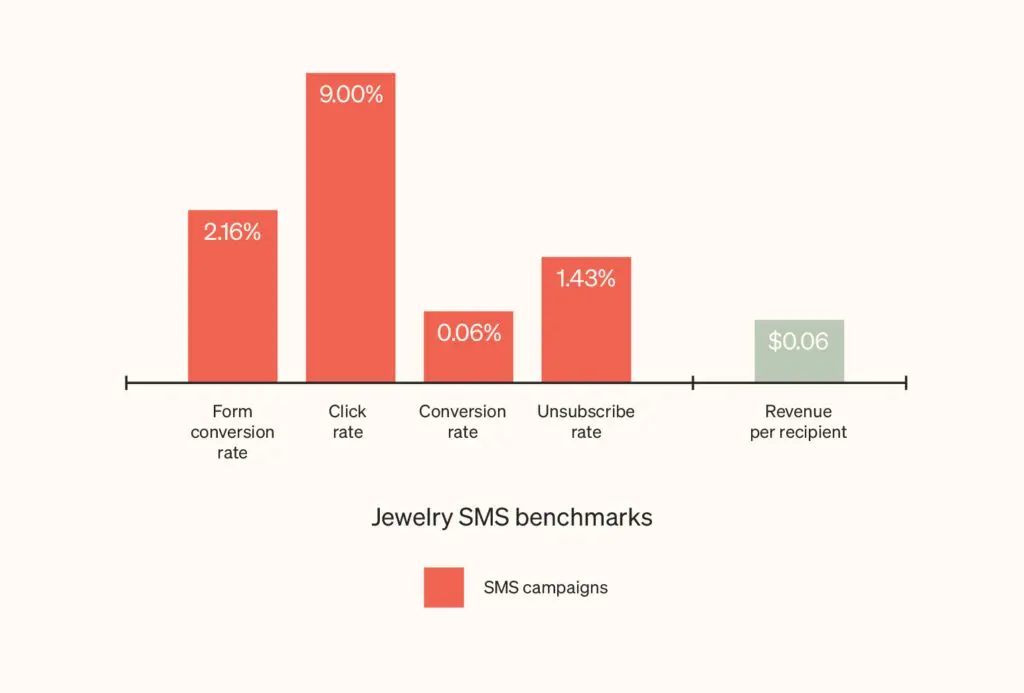
Based on these email and SMS benchmarks, fashion brands can understand if they are keeping pace with competitors—and continue working to improve performance.
Fashion ecommerce best practices for integrated marketing
To start capitalizing on email and SMS marketing, you have to understand the end-to-end customer journey and all the touchpoints that lead website visitors through different stages with the ultimate goal of converting them into customers.
Let’s take a look at what that integrated marketing funnel looks like for fashion brands.
Build an audience using forms
Building an audience is a prerequisite for all your marketing efforts later on. If you don’t have a solid email and SMS subscriber list, your marketing strategy will fail. One of the best ways to start building your subscriber list is using the sign-up form on your website.
Turning visitors into customers can seem like a huge leap. To make things easier, prioritize turning visitors into subscribers (both email and SMS). Once you get consent to send them an email and SMS campaign, it’s much easier to convince them to make the first purchase.
Maternity brand Blanqi uses a sign-up form to build its email subscriber list. To encourage visitors to sign up, Blanqi offers a 15% discount. Besides asking for their email address, Blanqi also uses the sign-up form to get more information so they can later segment their list based on the data they collect.
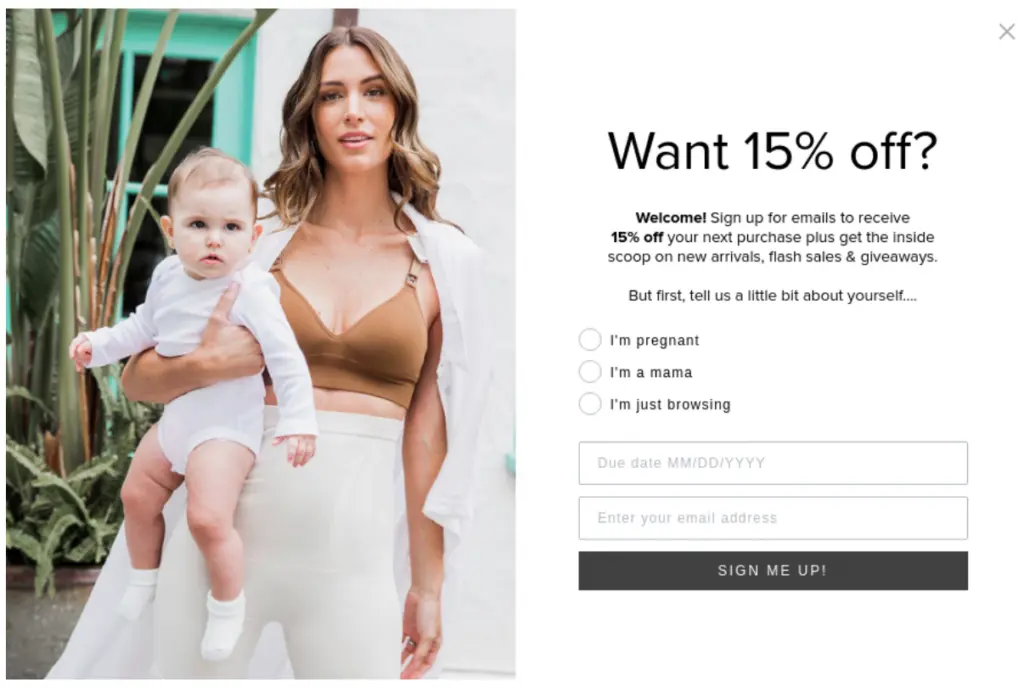
Most sign-up forms ask for an email address or phone number, but requesting more data can help you build powerful connections with subscribers. Asking a few related questions to customize the buyer journey makes it a no-brainer for subscribers to tell you more about themselves.
Engage audiences with welcome streams and storytelling
First impressions matter. The way you kick off the relationship with new subscribers can make or break your business. That’s why fashion companies dedicate time to creating welcome series that convert.
Customer lifecycle marketing helps you address this critical stage because it’s your opportunity to introduce new, interested prospects to your business and product offering. With a welcome series, you can build trust, introduce products, thank subscribers, gather customer preferences, and increase conversions.

You may wonder how many emails to include in your welcome flow. While this depends on what you want to say to your audience and the best way to see what works is to test and optimize, a good rule of thumb is 3-4 emails over the course of a week.
When building out your welcome series, it’s best to decide how many messages you’ll send and over what total timeframe before adding time delays.
Taylor Stitch specializes in high-quality men’s and women’s clothing for discerning consumers. The brand is committed to building the best possible clothing while pledging to limit its environmental impact. Since the welcome series is the first message prospects and customers receive, storytelling is an essential element.

Your welcome email should inspire and entice subscribers, so the best way to stand out is to tell a story. This is especially true for fashion brands.
“The ecommerce apparel and accessory industry is now even more competitive with the combination of influencer marketing and the rise of TikTok. One way for these brands to stand out is to focus on storytelling,” says Sam Alder, lead CRM strategist, Ragnarok.
“Writing a plain product description with a singular CTA in an email design is not enough to entice and inspire a consumer to convert. All brands should focus on some form of storytelling. Since apparel and accessory brands are so ubiquitous and online shopping is so accessible today, it’s even more important for that vertical to be as captivating and agile as possible.”
Another great example of brand storytelling is made-to-order brand Mirror Palais, founded in 2019 by Marcelo Gaia.
“Gaia has built a brand with a cult following. I believe his success can be attributed to not only his eye-catching designs but the storytelling he weaves throughout his entire digital marketing presence,” Alder points out. “His stories focus on the importance of size inclusivity and his upbringing in Queens, and he cites his mother as his inspiration and his background as a Brazilian. Purchasing a made-to-order product from Mirror Palais feels more like owning a piece of his story than a garment.”
Move audiences to purchase with browse abandonment and abandoned cart flows
Browsing through the product feed and adding products to the cart without making a purchase is the digital version of window shopping. But if you’re not trying to convert window shoppers, you’re wasting a prime opportunity for more sales.
Using browse abandonment and abandoned cart flows, fashion brands can easily target visitors with the right message and get them closer to purchasing.
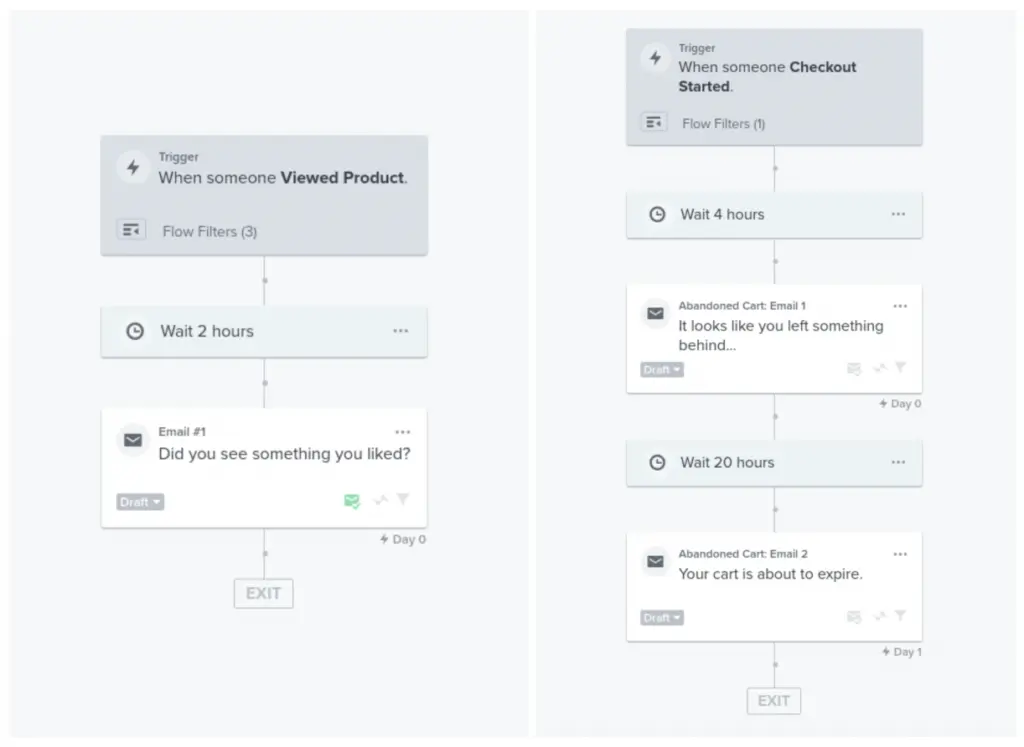
The browse abandonment flow is typically a lighter touchpoint, as it’s for customers who just visit a product page without adding an item to their shopping cart. You can use email or SMS to remind the customers of some of the products they browsed.
Abandoned carts flows are a message or sequence of messages you send to someone who added an item to their shopping cart but failed to complete their purchase. According to Baymard, almost 70% of shopping carts are abandoned on average. If you don’t follow up with these customers, you’re leaving money on the table.
Since adding a product to the cart is a strong way of expressing interest, fashion brands can use both email and SMS marketing to re-engage customers who left during the checkout process and encourage them to come back to complete their purchase.
There are several different ways you can set up these flows. Some brands, like SKIMS, include customer reviews and testimonials in their emails to improve conversion:

Other brands, like Girlfriend Collective, use creative copywriting to advance the brand narrative and move the customer closer to purchase.

And then, of course, many brands, like Alex Mill, use discount codes to entice customers to buy the item that caught their eye.

Follow up with post-purchase information
The moment a customer makes a purchase is an excellent opportunity to set the foundation for a long-lasting customer relationship. And yet, many brands miss the chance to make this impression by setting up a post-purchase flow.
A post-purchase flow is a great way to thank customers for their purchase and ask for a product review (if the item has been delivered), or push for a cross- or up-sell. Based on whether you’re contacting a first-time buyer or a repeat customer, you can set up a different post-purchase flow.
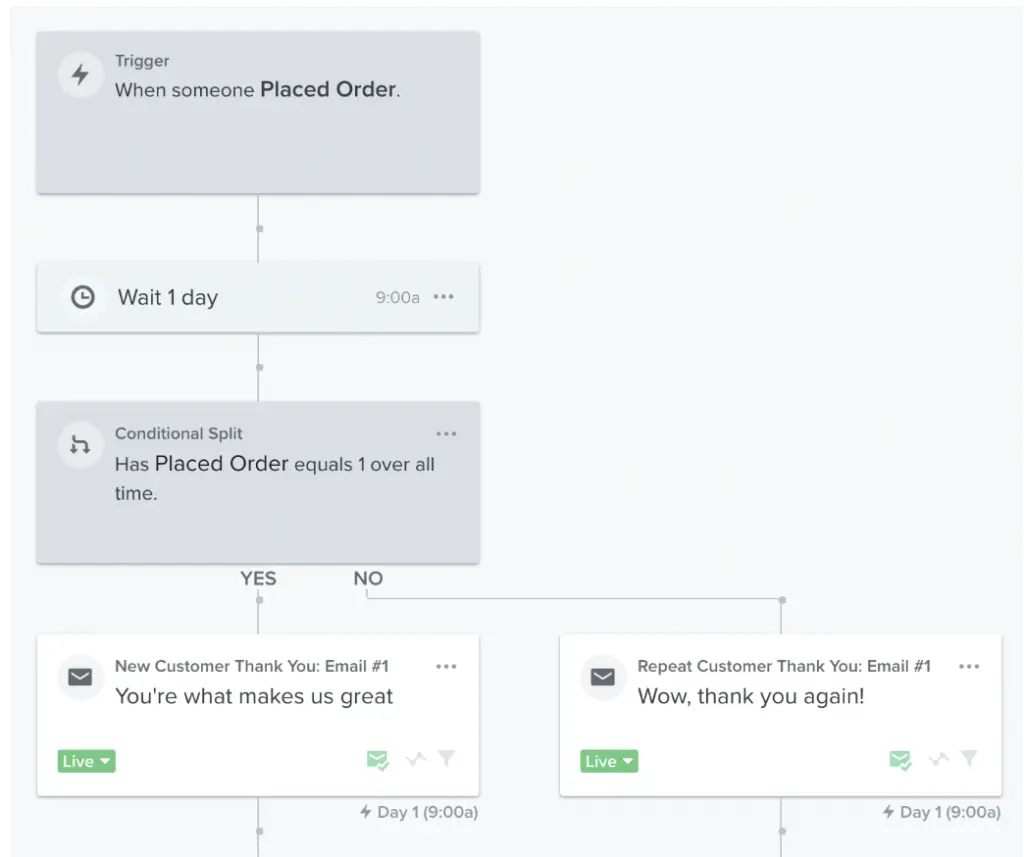
Sweatproof jewelry brand OXB uses the post-purchase email to thank customers for their purchase with a personal note from the founders.

Whether you choose email or SMS for your post-purchase flow, look at it as a way to ensure customer satisfaction, collect feedback, and tempt people to come back to your site and make another purchase.
The ultimate goal is to create an exceptional customer experience.
Collect Customer-First Data to create personalized experiences at scale
The best way to segment your list and create a personalized experience at scale is to focus on gathering Customer-First Data.
Catbird is a New York City-based jewelry company that specializes in ethically sourced, demi-fine, handmade pieces. Because buying a piece of jewelry or an engagement ring is an emotional purchase and often takes time, Catbird is dedicated to getting to know each customer well in order to help them find the perfect piece of jewelry.
The brand uses a sign-up form to collect email addresses, but also a birth date to offer customers a discount and a special birthday treat.
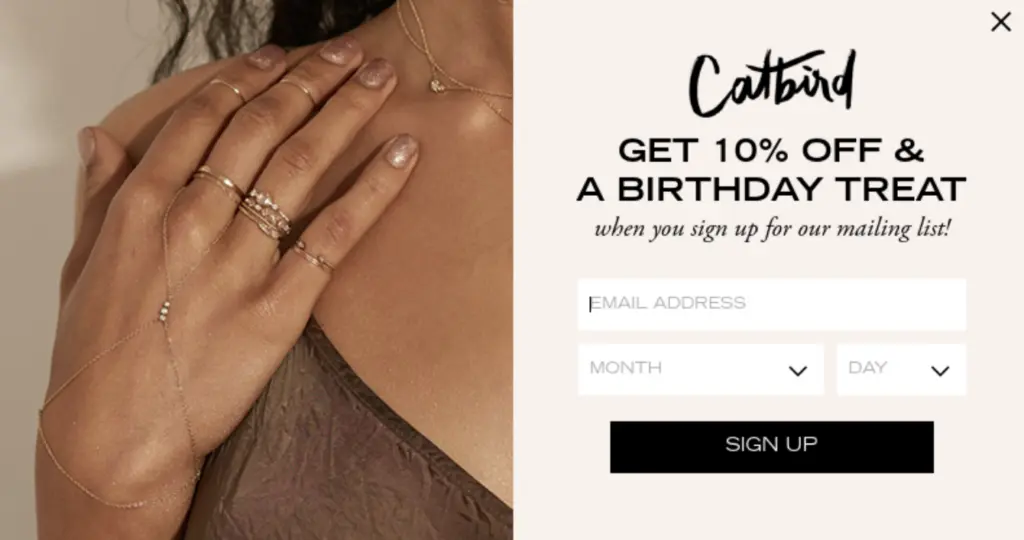
Catbird also offers virtual consultations, asking customers to fill out a form with a few personal details before the styling appointment. After the consultation, Catbird follows up with photos, sizing details, and other information.
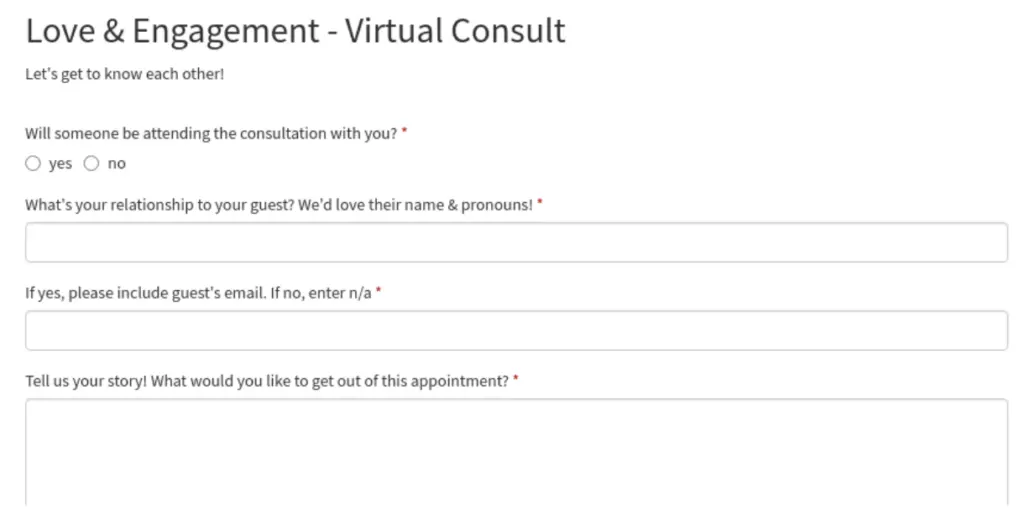
The digital ecommerce landscape is saturated, so differentiation is key. The Customer-First Data you collect can be a great foundation for creating segments and personalizing the customer experience.
Retain customers and grow lifetime value
The fashion industry is not immune to skyrocketing acquisition costs. At a time when earning new customers is harder than ever, customer retention must become a top priority for fashion brands.
Finding ways to retain customers and grow their lifetime value through campaigns, win-back email series, back-in-stock flows, and customer loyalty programs is table stakes for fashion businesses.
Jewelry and accessories brand Dear Mushka uses SMS to notify customers when items they love are back in stock and offer them exclusive access before everyone else. It’s a unique way to show customers they care.
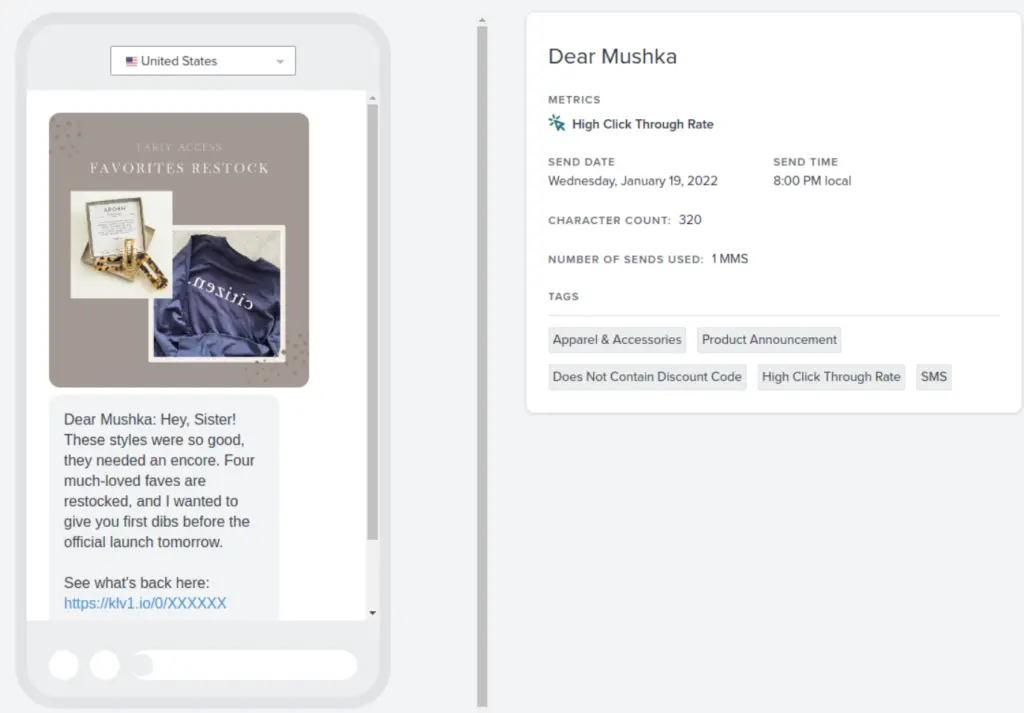
Consumer behavior and the business environment are changing fast. It’s critical for companies to build customer loyalty and improve customer lifetime value.
9 fashion industry SMS and email examples
When it comes to email and SMS marketing for fashion brands, there are countless possibilities for delighting customers every step of the way.
To get your creative juices flowing, we’ve compiled a list of 9 email and SMS ideas from leading fashion brands.
1) Dagne Dover
Dagne Dover is a DTC brand that makes a wide variety of performance-driven bags for work and leisure. Email and SMS marketing revenue accounts for 25% of Dagne Dover’s sales every quarter.
Besides introducing new products, promoting collections, and notifying customers about sales, Dagne Dover uses email to address customer concerns. In one of their email campaigns, the brand answers their customers’ most frequently asked questions:

If you get the same questions over and over again, it means that more customers are interested in finding out the answers. Email can be a great tool to answer the top questions and give customers all the information they need to make a decision.
2) Birdies
User-generated content (UGC) is a great way to support your email marketing efforts with social proof. Female-founded footwear brand Birdies uses UGC to inform customers about a bestseller that is back in stock and inspire them with authentic product images from other customers and content creators.

Over the past few years, UGC has become a powerful tool for inspiring customers, creating trust, and promoting authenticity. Since the fashion industry is based on visuals and aesthetics, UGC can help you source visuals you can later repurpose in your email and SMS marketing.
3) Draper James
Customers love giveaways, and fashion businesses use them as a marketing strategy to boost engagement from existing and new customers.
Draper James is a retail brand founded by Reese Witherspoon, focusing on fashion and accessories. The brand often partners with other businesses to launch giveaways, usually gift cards.

Partnering with other businesses for a giveaway is a simple way to reach a whole new segment and increase your email and SMS subscriber list.
4) Girlfriend Collective
Sustainable activewear brand Girlfriend Collective puts email and SMS at the heart of its marketing strategy. To build its audience, the brand uses a two-step signup form, asking website visitors for an email address and a phone number.
To incentivize visitors, Girlfriend Collective offers a 15% discount for visitors that enter their email addresses, and a 20% discount if visitors share their numbers as well.
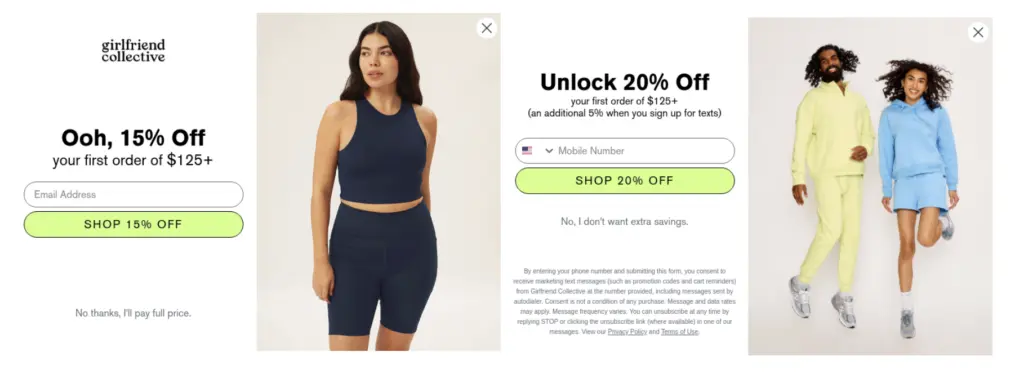
Another interesting approach from Girlfriend Collective is offering product bundles, giving customers ready-made combinations they can shop with a click of a button.

The key to product bundles is making a few different combinations that suit different tastes, and offering a discount which will give customers one more reason to purchase the whole bundle rather than the individual items it contains.
5) Birdy Grey
Customer information doesn’t need to be a black box. Fashion brands collect Customer-First Data to more effectively segment their subscriber list.
DTC bridal brand Birdy Grey uses a sign-up form to not only collect email addresses and phone numbers, but also find out whether the visitor is a bride, maid of honor, bridesmaid, groomsman, or regular visitor.
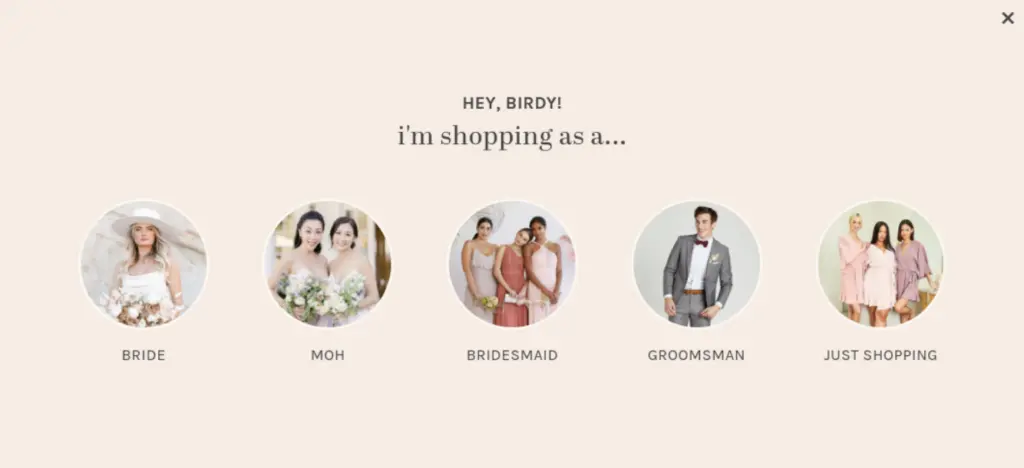
Based on the information the customer provides, Birdy Grey sends a targeted email featuring relevant product recommendations.

Customers love getting a personalized shopping experience. Collecting relevant customer information is the easiest way to understand each customer’s unique needs and help them find exactly what they’re looking for.
6) Curateur
Email and SMS have their own advantages and disadvantages, but they tend to complement each other when used together.
Curateur, a luxury subscription service curated by designer Rachel Zoe, combines email and SMS to reach subscribers and notify them about the latest curation.

With email marketing, you can reach a large portion of your target market. Another benefit is that you can send more often than SMS and communicate more directly than you can in paid or organic marketing.
But the biggest benefit of using SMS marketing is that people check their texts almost immediately after receiving them. If you want to send an urgent message, SMS is the way to do it.

“More brands should look at ways to improve cross-pollination between their different channels,” says Wei Tan, co-founder, The Orchard Agency. “Not all your fans are following you on your social channels, or subscribing to your email or SMS mailing lists. There are opportunities to improve message visibility by ensuring you are reaching your customers across all of your various marketing touchpoints.”
The bottom line: the best way to maximize your marketing efforts is to combine email and SMS across the customer journey.
7) Atoms
The moment visitors subscribe to the Atoms newsletter, they can customize their email preferences. For the footwear brand, thoughtfulness and atomic attention to detail are a top priority—which is why they ask subscribers to opt in to specific communications right off the bat.

Asking customers for email preferences early in the process can help you deliver relevant messages that customers care about from day one. Atoms also uses its email subscriber list to encourage SMS subscriptions.
Offering VIP treatment, exclusive text-only offers, updates, and product launches are just some of the ways to get email subscribers to join your SMS list.
8) Charlotte Stone
Imagine getting an email with all the shoes you browsed a few days ago. You would be tempted to check out again, wouldn’t you?
This is exactly what Charlotte Stone does by using browse abandonment flows. The footwear brand is nailing the email personalization game with communications like this one, which features shoes the visitor browsed previously:

If you’re looking for ways to spice up your email and SMS marketing with personalized messages, focus on behavioral data. Showing customers you understand their needs will help you pave the path to purchase.
Prep for the future of fashion ecommerce
A new era in the fashion business is about to unfold, and now is the time to embrace it. If you want to stay competitive in the fierce fashion ecommerce environment, you can’t afford to sit on the sidelines.
Using owned marketing channels like email and SMS marketing will allow you to create a delightful customer experience and future-proof your business. The next step is making sure your tech is ready to support you.


